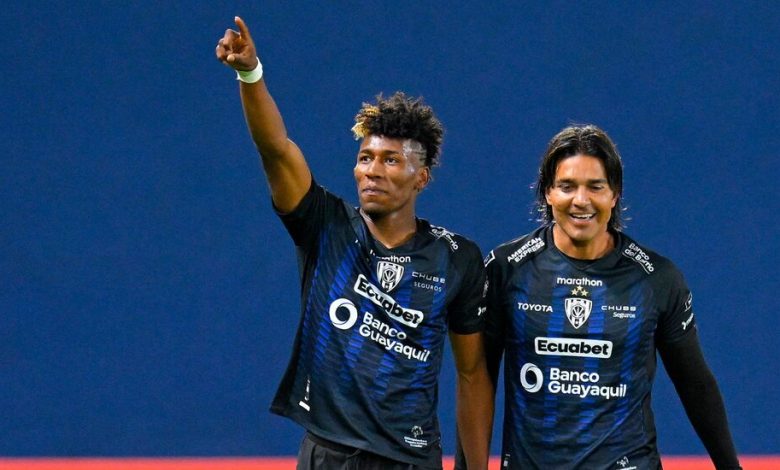Soccer’s Next Big Thing Is Buying in Bulk

On Wednesday evening, the Colombian club Atlético Huila decided to treat its players and its coaching staff to what could be best thought of as an office night out. Huila has had a rough season. It finished at the bottom of the Apertura, the first half of the Colombian campaign. It won only five of its 20 games. A field trip was more a restorative than a reward.
It was a good night, too. Huila’s squad has spent the last week in Sangolqui, a suburb of Ecuador’s capital, Quito, finishing off its preparations for the second half of the season as guests of Independiente del Valle. The host duly offered Huila an invitation to watch its Copa Libertadores game against Argentinos Juniors at its compact, modern stadium.
What Huila’s players saw was, first and foremost, rousing entertainment. Thanks to a last-ditch goal from Kevin Rodríguez, Independiente won, 3-2, securing the top spot in its group in the process. More important, as they posed for a group photograph against the empty stands of the Estadio Banco Guayaquil after the final whistle, Huila’s players will have known they had seen a glimpse of their — or at least their club’s — future.
Back in March, speaking at the Financial Times Business of Football summit, the Newcastle United minority owner Amanda Staveley confirmed that the English club was exploring the idea of establishing a worldwide network of teams.
That, in itself, was no great surprise. Over the last few years, the concept of building a stable of clubs has become de rigueur in soccer. Red Bull pioneered the model, in Salzburg and Leipzig, New York and São Paulo. Manchester City, through City Football Group, industrialized it; its portfolio now encompasses more than a dozen clubs, spread as far afield as Uruguay and India.
Since then, anyone who is anyone has followed suit. Indeed, that is what was most striking about Staveley’s announcement: not what she said, but how she said it. Newcastle, she told the conference, was pursuing “multiclub.” Not “a multiclub model.” Just “multiclub.” Owning multiple teams across disparate leagues has become so commonplace that it is now a noun.
Dozens of teams have now been subsumed into these models. Genoa, Standard Liège, Hertha Berlin and Sevilla are all part of the same group. Botafogo, RWD Molenbeek and Lyon are linked through another. Brighton has a connection to Union Saint-Gilloise (everyone has a club in Belgium). This week, Chelsea’s ever-disruptive owners bought a majority share in the French team Strasbourg.
The rationale, on paper, is this: Owning a network of teams should allow owners to share best practices more easily while reducing risk and increasing efficiency in the transfer market. A network should, if constructed correctly, function as a two-way talent pipeline: The best players rise to the top of the pyramid, while those who fall by the wayside have landing spots farther down, meaning there is far less waste.
That is the theory. The practice is a little different. Leipzig and Salzburg apart, it is not clear if anyone has managed to make the idea work, at least at scale. Players do not move from Montevideo City Torque to Girona to Manchester City. The portfolio approach to soccer, for now, remains very much in beta.
There is a reason people keep trying it, though. For the clubs that form the networks — especially for those teams outside the wealthy enclaves of England’s Premier League and Europe’s elite — collective safety offers a degree of economic stability. It may even, at some point, give them access to a higher caliber of player than they’d otherwise get.
And yet, in another light, the trend represents something significantly more troubling: not so much an inevitable conclusion to the sport’s flirtation with high finance but something far closer to an existential threat.
Often, that is framed as an issue of competitive integrity: What will happen, for example, if two teams from the same group encounter each other in European competition? But perhaps more pressing is whether being part of a larger group fundamentally changes the purpose of a club. Does it alter the meaning of a team when it is no longer an entity trying to succeed on its own terms but is instead either a proving ground for talent or a parking lot for castoffs?
These are questions UEFA, at least, does not seem in a hurry to answer. The organization’s president, Aleksander Ceferin, has performed a significant about face on the subject, going from immediate, reflexive objection to hinting that the body will change its rules to accommodate the new reality. The conclusion, as always, is that soccer is happy to grant forgiveness, even if you do not ask permission.
Still, there is sufficient organic skepticism that — as a rule — these deals are announced as gently as possible. Freshly minted member clubs are offered soothing reassurances about their autonomy. The connections are, to some extent, downplayed. The precise purpose is always oblique. There are, it is fair to say, not many cases where one team poses happily for a photo in the stadium of its new stablemate.
Last month, Atlético Huila was acquired by Grupo Independiente, an investment consortium headed by Michel Deller, an Ecuadorean real estate magnate. His wealth, though, was not the main source of the group’s appeal.
It was instead the success he and his partners have had with Independiente del Valle, the club they bought 15 years ago and turned, at blistering speed, into what may be the most forward-thinking team in Latin America.
As Juan Carlos Patarroyo, the outgoing president of Huila, said, Independiente now stands as the “guru” of South American soccer, a “pioneer in training, creating, producing and marketing professional players.”
The sophistication of its youth system is the envy of the continent: the regional training bases placed deliberately in the most fertile areas of the country, the in-house tournaments that attract scouts from across the world. Independiente has produced not just Ecuador’s current golden boy, Moisés Caicedo, but also Kendry Paéz, his heir apparent. It is not bad going, given that Paéz, at 16, is older than the current iteration of the club.
No less impressive have been the results. Independiente is not just a finishing school. Deller, thanks to considerable investment and a sharp eye for coaching talent, has turned his project into a genuine continental force. Independiente was a Libertadores finalist in 2016, and it won the Copa Sudamericana in 2019 and 2022.
Most significant, though, has been its broader impact on soccer in Ecuador. At the World Cup last year, 10 of the 26 players on Ecuador’s squad bore Independiente’s imprimatur: They had spent some, or all, of their careers in Sangolqui. Led by Paéz, Ecuador finished as runners-up in this year’s South American under-17 championship, ahead of Argentina, to earn a place in the under-17 World Cup.
And now, through Huila, Deller has set himself the target of doing exactly the same in Colombia. The conditions, he believes, are similar: an abundance of young talent, much of it currently lost through carelessness, to be harnessed; a club more than willing to adopt his methods and apply his knowledge.
“We are going to contribute a lot with know-how and experience,” Santiago Morales, Independiente’s general manager, said after the takeover was completed. “We will give new ideas and initiatives, but above all we have a commitment to train players. Soon, we will have Colombia playing in youth tournaments in South America and the world.”
That is the plan, anyway. Given all Independiente has accomplished, it is easy to believe they will be able to meet their lofty promises. In doing so, they would not only lift Atlético Huila, but Colombia as a whole. And more than that, they may even prove that there is a way to make soccer’s latest theory work in practice, too.
Common Sense Revolution
Francesca Whitfield is not exactly a household name. As the head of group planning at Manchester United, she probably would not expect to be. Her background is in the corporate sector; United recruited her, initially, as a financial analyst. Still, this week she did two things so rare, and so unexpected, that they deserve to be celebrated.
It is impressive enough that, while speaking at the inaugural Women’s Football Summit — the European Clubs’ Association had not thought to organize one before 2023, which is pretty telling, really — Whitfield suggested that women’s soccer should seek to “adopt financial regulation much earlier in the women’s game than we did in the men’s.”
This is, of course, so sensible that it almost borders on obvious, but Whitfield’s belief — that women’s soccer should not seek to “emulate or replicate” the men’s game — remains surprisingly revolutionary. Curiously few people in women’s soccer seem to be aware that they do not have to be hidebound by a set of flawed conventions designed for a bygone age.
More striking still, though, was the context for Whitfield’s comments. She works for one of the game’s apex predators, and yet she was publicly pushing for financial controls — either an “anchoring system” or “even something akin to a hard salary cap” — that might enable smaller clubs to compete.
“The wage inflation we are seeing is contributing to the gap between the larger and the smaller clubs,” she said, pointing out that while teams backed by major men’s clubs can cope, those run on tighter budgets are effectively being railroaded into irrelevance. “They can’t possibly ever be competitive with how things are.” She would like, she said, to see the issue addressed not by the leagues themselves, but “on a European level.”
Quite what form that financial control should take — a salary cap, a designated player system or even introducing a draft for out-of-contract players — is open to debate.
The sentiment, though, is worth heeding, not solely for women’s soccer, but the game as a whole. Everyone should be thinking about how to make the sport more competitive: between clubs, between leagues, between continents. Everyone, in other words, should be thinking a little more like Francesca Whitfield.
Afterthought
By the end, nobody felt the need to remember the start. It seemed too long ago, so much crammed into the month that had elapsed that it felt distant, as if it had happened in another era, or on another planet. Lionel Messi, rather reluctantly wearing a bisht, had lifted the World Cup trophy after a final that will likely go down as the greatest of them all. Qatar had the story it wanted, the tournament it wanted, the stage it wanted all along.
In the rush to unpack precisely what that meant — for soccer, for politics, for the Qatar’s human rights record and for the migrant workers who had died so that all of it might happen — it was easy to forget that it had begun with a humiliation.
Three minutes into the tournament’s opening game, Qatar’s national team had conceded a goal to Ecuador. It was — very narrowly — ruled out for offside, but it set the tone. Inside 16 minutes, Qatar was behind. The host lost that game. Then it lost to Senegal, ensuring it would not reach the knockout stage. A final defeat, to the Netherlands, marked Qatar as the worst-performing host of all time.
Given the cost and the scale and the sheer controversy involved in staging the tournament, it is easy to assume that the Qatari authorities never really cared about the soccer part of it. That is not quite true: The country had spent years trying to hone a team to fly its flag.
It built the Aspire Academy, ensuring its young players had the finest facilities in the world, and explored using it to develop talent from across the planet. It invested in Eupen, a minor Belgian team, to expose its hot-housed prodigies to European soccer. It hired expert — and able — coaches to oversee their progress.
And it all failed. Qatar was not humiliated during the World Cup, but it is fair to assume that three games, and three defeats, was not quite the return it had anticipated. The results have not improved since then. In its opening game at the Gold Cup, Qatar’s national team — now under the aegis of the grizzled, irascible Carlos Queiroz — lost to Haiti.
There is a romance there, of course: Haiti, one of the poorest nations on earth, embattled in so many ways, sticking one in the eye of one of the richest countries. But it is a reminder, too, that while Qatar will look back on the World Cup as a resounding success, there was one aspect of the whole endeavor — the sporting one — that remained entirely beyond its grasp.
Correspondence
This newsletter likes to regard itself as a safe space. It’s best, perhaps, to think of it as a thought workshop: a place to challenge conventional thinking, to gaze upon the blue sky, to move so far outside the box that you realize the box itself is a circle. No idea is a bad idea: That’s the credo. Except for this one, from Shawn Donnelly.
“I just thought of a way to make soccer more exciting,” Shawn wrote, in what I can only assume was the very small hours of the morning. “Take a page out of the N.B.A.’s book and add three-pointers: three points for shots from outside the 18-yard box, two for shots from inside, and one for penalties.”
You’ll have spotted the problem here: What Shawn has done is not so much as take a page from the N.B.A.’s book as copy-and-paste it, verbatim.
Let’s think this through, though. Is the idea that teams who score more goals than others not something that should be incentivized? Could there not be a bonus point, as there is in rugby, for sides that score — say — four or more? Or would that simply give the elite teams even more of a structural advantage? Probably, but it is worth considering. This is why we should always workshop every idea, even if the raw material is, um, lacking. All goals should count equally. That is not a part of soccer we need to adjust.
Walid Neaz, on the other hand, has an idea that needs very little tweaking. “Why are the continental champions not awarded a spot in the World Cup?” he asked. “If it’s the showcase tournament, then it would stand to reason the champions for each continent have earned a spot?”
Yes, absolutely. This makes perfect sense. The reigning champions of each confederation should, of course, earn a bye straight into the World Cup. It would, as Walid points out, help to alleviate fixture congestion, just a little. It would reward long-term planning. And it may even increase the prestige of a couple of the continental tournaments.
Sadly, Walid already knows why it won’t happen. “More games means more eyeballs and more revenue to be sold for FIFA,” he pointed out in the coda to his email. (I’d add that it would mean the individual confederations’ accepting that their tournaments are upstream of the World Cup, which is not something their pride would allow.)



